The Eugenia Occultation
May 19, 2013
This event had a predicted path with little formal uncertainty; the 1-sigma zones were only 1/4 of the path width. And, Aptos was square in the center of the path. It was as close to a "sure thing" as would happen this year. And, the target star was just a degree away from naked eye Delta Cancri and the Beehive Star Cluster, so it should be easy to identify. That was the good news. The bad news was - it was faint. Very faint. The combined image was magnitude 11.9, dropping to 13.0 during the 7 second central predicted occultation. I still had not recovered my camcorder from Chris Kitting's place, and so would be doing it visually once again. I enlisted Gene and Duncan to man the 12" dome scope for the purpose of making a star trail during the occultation. Ideally, the target would disappear entirely, but instead we would have a 1.1 magnitude drop. Would it be clear enough on a noisy photo with the first quarter moon not far away?
Skies were cloud free, but we did have a marine layer and cool temperatures. I arrived at 8:10pm, went to my office on the main campus and printed copies of the finder charts for myself and for Gene and Duncan, then met them at the gate to the observatory. Gene wanted to practice getting the exposure right, turning off tracking at the right moment, and seeing if the online NIST time clock agreed with the voice WWV time (the WWV time was about 0.1 second sooner than the online NIST time, on Spock). I found the target star pretty easily, but it was too faint to have any confidence I'd be able to get the event. It turns out, as I looked at the first images on the CCD, that the asteroid and target were still far apart and this made both harder to see. When there was only 10 minutes left before the event, they were close enough to merge and show up well to my eye - or anyway, well enough. Until then, I'd doubted I could get a visual until that merge and apparent brightening.
It all came off just right. The asteroid path was right on, and I was able to see both the D and the R
start 5:03:45
D 5:04:50.70 for reaction time=0.77 sec , 51.56, 51.45 , 51.52, 51.47 -> 04:51.47 raw "D"
R 5:04:57.85 for reaction time =0.70 sec , 01.44, 01.46 -> 58.55 raw "R!"
end 5:05:44
Excel report
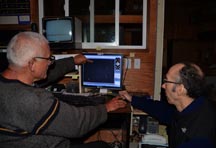
Gene and Duncan on Spock, identifying the target star and asteroid
|
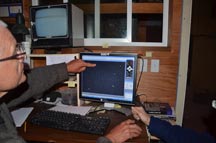
A closer view. Positive ID; the asteroid is clearly visible at 14th magnitude on 1 second "focus mode" exposures |
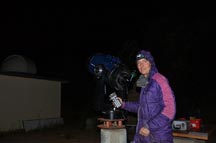
At the scope, after a successful event |
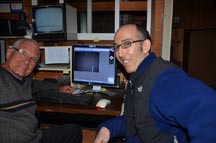
Gene and Duncan did their job well too - we got a nice star trail image including the dimmed target during the 7-second event |

The CCDOPS view, screen capture with crosshair set at my visual disappearance time, just to the right spot on the target's vertical star trail. Time moves from top towards bottom.
|
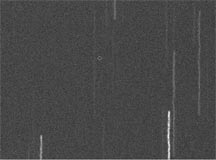
CCDOPS crosshairs set at my visual reappearance time
|
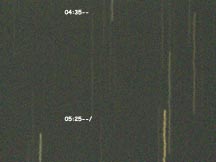
It's clear there's a dimming roughly around the time of the event, but it's hard to discern exactly when. My best guess and measurement says a startrail D at 04:48.0, and a startrail R at 04:53.1. The time of the star was recorded by CCDOPS at 04:35 and that is indeed when Gene says he carefully hit the 'start' key. |
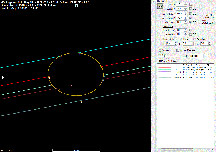
The OCCULT profile with best fitting ellipse from the 4 observers. Note my chord was exactly on the predicted centerline, hence the dotted line on top of my chord. This, and the next profile, can be found here |
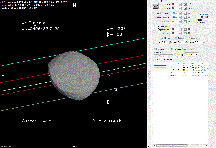
Eugenia also has an ISAM inversion model from photometry, and this is the best-fitting orientation to the 3 digital video chords. However, the south side of the asteroid clearly doesn't fit well; Bob Jone's miss and my shorter chord would seem to argue for a smaller southern half. |
Derek had a success with his video setup, and the images are here . Derek's D was a second before mine, and his R almost a second later, so it looks like there was a bit of a north shift. That makes me feel better about my visual timings, but it doesn't look like the star trail image is useful. Make a note - count on such methods of timing only for higher S/N events. Brad Timerson produced the OCCULT profile with all the observations.








